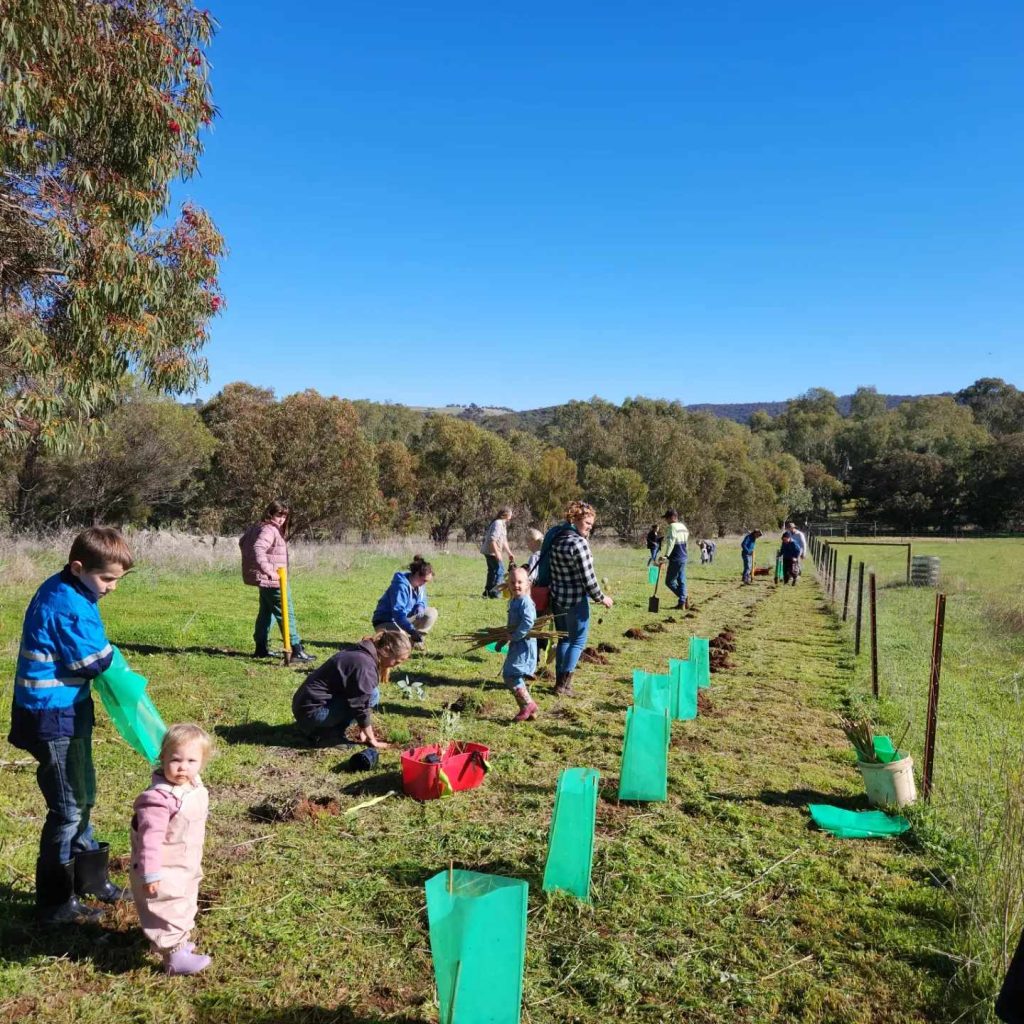West Toodyay Community Tree Planting
by Nicole Coleman
Last year, the Wheatbelt Natural Resource Management Inc offered small grants to landholders to improve ground cover and on-land fodder options for livestock. A neighbour (Anita) and I decided to submit a joint application. My husband Nathan and I live on a 10-acre property in the Avon River Valley in West Toodyay, with approximately 100m between our bottom boundary and the river. We run a small herd of dairy goats (Anglo Nubians) and a small flock of sheep, keeping stock numbers low in line with the Dry Sheep Equivalent stocking rate appropriate for our property. We manage our property using permaculture and regenerative agriculture principles, including the use of integrated animal management systems designed to support regeneration. Our neighbours/co applicants also have ten acres of mixed pasture/rocky outcrops, uphill and away from the river from us by 500m as the crow flies. They run a small mixed herd of dorper sheep, alpacas and ponies.
Through this project we aimed to:
- increase native wildlife habitat, including Carnaby black cockatoos whom we know visit the area periodically.
- decrease water run-off from the properties – so that water flow slows and soaks into the soil, increasing soil moisture and reducing erosion and run off into the Avon Valley River catchment.
- decrease prevalence of unwanted weeds.
- increase feed availability and decrease reliance on off-property feed, resulting in less overgrazing due to shrub and tree fodder meeting the summer feed gap.
- increase soil biodiversity and nutrient availability.
We were very happy to be approved for the funding, and at the end of last year Anita and I extensively researched livestock-palatable species that were endemic or naturalised to our region, selecting multiple species from ground cover (eg pig face, creeping grevilleas) to bushes (bottlebrush, saltbush) to mid size, fast growing trees (acacias, sheoaks and tagasaste) to large canopy trees (wandoo, York gum) in order to recreate the type of natural bushland that would have existed prior to clearing. We ordered our selections from Misty Ridge Plant Nursery in Wundowie, ready to be collected for planting this winter.
In the meantime, I have experienced some health issues, resulting in a diagnosis of fibromyalgia late last year, a break from paid employment and a rapid recalibration of what being a property owner and permaculture practitioner looks like with decreased physical capacity. The pendulum has swung wildly from ‘we need to sell up and move to a town block’ to ‘we are where we need to be, and everything will unfold as it should.’ During this challenging time I have revisited the core ethics of permaculture – people care, earth care and fair share – and particularly ‘People Care’. This is both a call to action, and an affirmation. We must PRACTISE ‘people care’, while remembering (and believing) that people truly do care.
Knowing that I would be very unlikely to be able to plant even a fraction of the 500 trees we had to get into the ground, Nathan and I decided to hold a community planting day. We have been getting involved with the ‘Toodyay Landcare and Grazing’ fledgling group and also saw this as a very good way to get similarly minded people together with the view of creating a learning and social community of local regeneratively-minded landholders, building some traction within the group. We advertised the day, organised a feed and asked Wheatbelt NRM to attend and speak about the funding program. On the very cold but fortunately sunny day, we had 27 people of all ages attend and all 500 plants were put into the ground, with tree guards around half of them, exceeding my wildest expectations about how the day would go.
I must admit to struggling with having so many busy people rock up to work on my property – the guilt kicked in early and stayed. I needed to trust that people really do care, that we have put work into forming close community around us, and that our own observance of the ethics of permaculture mean that (hopefully) no one sees our need for help as a one-sided venture. I struggled with watching people dig and bend and carry and plant, whilst worrying that my own need to take constant breaks looked like laziness. But throughout the day I heard so many conversations about what people are up to on their own properties, what people would like to see occurring in this space locally, and ideas being sprouted of further actions that can be conceptualised. Connections were made, learning occurred, and it warmed my heart to see so many young people being involved right till the very end.
I am so grateful for the love, time and energy that everyone brought to this day, and am inspired to continue to interrogate the permaculture ethics and principles through the lense of accessibility – not just physical accessibility, but also how we bring people into the Permie fold where there might be other barriers – finances, education, mental health, location, family structure to name a few – and how community is always, MUST be, at the centre.


